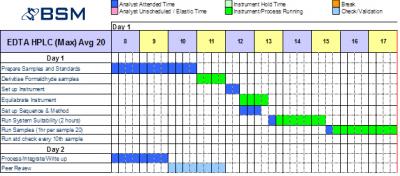Time studies, work measurement and standards - how not to alienate your team
A critical component of improving any existing process is first measuring it! “If you can’t measure it, you can’t improve it.” (Bohmer, 2008) There are multiple tools for determining a process’ baseline, such as process mapping and spaghetti diagrams. Possibly, some of the more controversial tools are those used for work measurement and standards. There are four recognized methods for gathering information on the time it takes to perform a task (or set of tasks).
- Time Studies: Direct measurement, with a stopwatch, of the entire task
- Work Sampling: Direct measurement, with a stopwatch, of multiple portions of the task
- Predetermined Motion-Time Data Systems (PMTS): Indirect measurement using tables of generic motion times
- Elemental Data: Indirect measurement using databases of similar tasks
Work measurement has long been controversial and unions, in particular, are frequently suspicious of, or even opposed to, their use, as means to squeeze workers for more productivity by setting unrealistic targets. At the very least, the recognized methods foster an adversarial relationship between managers and workers. It is certainly easy to imagine becoming uncomfortable in a situation where a stranger follows you around with a stopwatch timing your every move. As for the indirect systems, I can certainly see how it would be aggravating to be told how long your job should take by someone who has never set foot in your workplace area.
There are also questions around accuracy. For direct “stopwatch” time studies, there is always the risk that you measure an outlier (an unusual event that leads to the measurement being either much slower, or faster, than normal). The only way to abate this risk is to perform the measurement multiple times using different combinations of people and equipment. But this can be very time consuming, especially if the process to be measured has a long cycle time. For indirect methods, there is no guarantee that the combinations and timings of the generic times used will accurately reflect the exact environment being measured.
But there is a less adversarial method for determining standard times. Ask! Surprisingly, the most obvious method of gathering data on work standards is rarely recognized as a viable tool. It is reasonable to assume that a person who regularly performs the task of interest will have a good understanding of how long it should take! Working as a consultant for the last 8 years, I have had to gather standard work times more times than I can remember. I do this in a structured way in 2 separate sittings.
- In the first sitting ask the Subject Matter Expert (SME) how long it takes to perform a task for a specified number of samples e.g. “How long does it take to safely dispose of 10 samples?”
- This is followed up at a later sitting with a more detailed, step by step, review using a standard time template (see Figure 1), where we:
- List the activities performed in the correct order
- Map the time (both attended and unattended) for each activity
- Finally sanity check the overall output versus step 1, versus the SME’s experience and versus any stored process data, if available e.g. ERP timestamps.
Step 2 is done in a group setting with 2-3 SME’s. This allows for a consensus to be reached and minimizes a bias towards any particular individuals’ time i.e. we aim to build it for the average worker. Not the best, nor the worst.
Figure 1: Standard Time Template
There are a number of distinct advantages that this approach has over the 4 traditional ones mentioned above. Firstly it replaces the adversarial relationship with one that is based on mutual respect and trust. Everyone is made to understand that the goal is to build a standard that is fair for everyone. Workers often complain that the reward for being good at their job is that they get more work and the reward for being poor is the opposite. Having clear, achievable standards for everybody is recognized as being fair by the vast majority of workers. Another advantage of this approach is that it is much quicker than direct measurement. To fill the template for a 2 day task takes approximately 30-60 minutes. To directly measure it once would take 2 days! Finally, it is hard for other workers to argue against the new standard when it has been designed by their peers.
There are two main questions that I often receive for this approach. How can you trust the employees to give you accurate times? And how can you be sure it’s accurate if you don’t measure it? The key is using a group of 2-3 SME’s when filling the standard work. The group will eventually come to a consensus with their peers which tends towards the average rather than any individuals dramatically different time estimate. It’s hard to argue that a process takes 10 hours when your peer says they completed it in 5 hours last week. I’ve commented on the lack of accuracy of direct measurement earlier. The power of this approach is that the workers themselves are holding each other accountable for consistently meeting an agreed upon fair target.
I will note one caveat for this approach. In my experience, humans are not good at estimating short time periods, in the order of seconds or minutes. The difference between 20 seconds and 40 seconds to a human is negligible but to a process it’s a difference of 100%. So for very short cycle processes I will concede that this approach is not feasible. However, for processes of 2 or more hours, I believe that this approach has a number of significant advantages over the 4 traditional methods.
Our consultants can provide further information on the above and discuss any aspect of Real Lean Transformation, simply set-up a call today.


